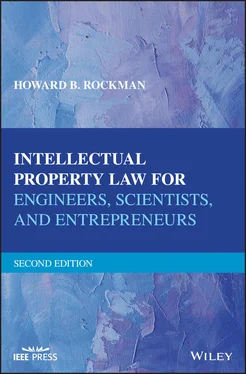Professor George Uslenghi, Associate Dean of the College of Engineering at UIC, suggested that the series of lectures that I prepared, with augmentation, be prepared as a draft manuscript and submitted for publication. Professor Uslenghi determined that a proper background in intellectual property modalities was becoming increasingly important for an engineer and scientist to have an awareness of. To make a long story into a saga, the result of the professor’s suggestion was the first edition of this text, published in 2004.
The publisher of this text asked me recently to prepare a second edition to update the information in the first edition, as necessary, to bring newly developed information about intellectual property law to you, the reader. For example, since 2004, U.S. Patent Law has been significantly amended by passage of the American Invents Act (AIA) in 2011, most importantly to grant patent rights to the first to file a patent application, and not the first to invent, when two or more inventors or groups of inventors have nearly simultaneously filed patent applications covering the same or similar inventions. In addition, the applicable law governing the patent eligibility of computer‐related and life science inventions has been modified radically in recent years as a result of court decisions. Several other recent nuances in patent law are also updated and explained in this second edition, such as new procedures allowing others to challenge the issuance of a patent before the U.S. Patent and Trademark Office (USPTO), and thus avoiding litigation in the federal courts.
In addition, the U.S. Congress, in 2016, enacted the Federal Defend Trade Secrets Act, which provides additional remedies for those whose trade secrets or confidential information have been misappropriated by someone else, such as a former employee. This new federal law now runs parallel to the various state statutory and common law trade secret laws protecting trade secrets. Also, this second edition includes expanded materials regarding the commercialization and management of intellectual property assets, technology transfer, and enforcement of intellectual property rights.
This text was not written to be read from cover to cover in one sitting. The table of contents and index have been carefully crafted to allow you, the reader, to go directly to the information you need regarding a specific project in which you are involved. For example, I expect electrical and mechanical engineers to avoid the chapter on biotechnology.
A major purpose of this text is to enable you, as an inventor or creator, to efficiently interface with an intellectual property attorney, for example, and provide him or her with information enabling you to obtain the maximum protection for your invention or creation. On the other side of the coin, the text material will aid you and your intellectual property attorney to take steps to ensure that your invention or creation does not infringe upon the intellectual property rights of others. The last thing in the world you want is to invite a lawsuit when you introduce your new product or process to the world.
Included in this text are patent, copyright, trade secret, mask work, trademark, and cybersquatting legal and procedural principles, as well as how to properly use the new vehicles of intellectual property protection for novel software, biotech, and business method inventions. Also, this text covers trademark protection for domain names, and other ancillary matters that fall within the genre of intellectual property protection.
The material in the pages that follow also provides you with information regarding employment contracts as they relate to an assignment of intellectual property rights to an employer, the concepts of confidentiality of proprietary information, and covenants not to compete following a change in employment. With increasing movement between employment positions, typical covenants not to compete in employment contracts are receiving closer scrutiny by the courts, and by state legislatures.
By no means is this text intended to transform you into an intellectual property attorney, or to do the work of one. The purpose is to provide you with knowledge of a very arcane, but important, adjunct to the technology professions, that of the protection of the technology you develop, and the steps necessary to prevent stepping on the intellectual property “toes” of others.
Between each of the chapters of this second edition, I have placed essays on famous and noteworthy inventors and their inventions, followed by a copy of the first page of patents resulting from these inventors’ efforts. A complete copy of each patent may be obtained from the USPTO website ( http://patft.uspto.gov/netahtml/srchnum.htm). The feedback I received from the first edition included comments that students who used the text for the course work enjoyed the inventor and invention essays interspersed between the chapters of the book. Taking these comments to heart, this second edition includes several additional essays of inventors and inventions I considered interesting. I hope you find these essays both interesting and informative. I found the research devoted to these historical incidents to be fascinating, particularly the differences between those who developed their inventions through diligent periods of trial and error, and others whose inventions resulted from acts of serendipity.
The content of this text does not provide everything there is to know about intellectual property protection. Such a text would be too thick to be mobile. In covering each of the subjects, I have taken you, the reader, to the point where your next step will be to consult with a competent intellectual property law professional to provide you with the detailed information necessary to protect the results of your intellectual endeavors. Keep in mind that neither I nor the publishers of this text are offering or rendering legal advice, or other professional services, to the reader. Also, since the law on any given subject changes constantly, it is important that you seek the advice of a competent intellectual property lawyer or agent to ensure that you receive the most updated advice available.
This text was not prepared to be completely read at one sitting. My purpose is to provide selected information on the several subjects addressed in the following pages that are of interest at any given moment in time, by consulting the index. Most importantly, the information in this text does not constitute legal advice. It is highly recommended that if you need advice as to a specific problem or question that you are facing, a qualified intellectual property law professional should be contacted.
Howard B. Rockman
rockman@rvoiplaw.com
I am greatly indebted to many people and organizations that assisted me in the preparation and production of this second edition. My thanks go out to each, and the order in which their names appear is not indicative of the degree of my appreciation. You were all awesome.
The publishers—IEEE Press and John Wiley & Sons—are to be commended for allowing me to present the intellectual property information in this work to the engineering, scientific, and entrepreneurial community. It is my fervent desire that, by bringing this material to those who generate inventions and creative works, a greater awareness will be created on how the worldwide intellectual property laws work to advance technology, science, and the creative arts, leading to more developments reaching the light of day. To Mary Hatcher, Sarah Keegan, Nicole Hanley, and Peter Mitchell of IEEE Press and John Wiley & Sons, thank you for your guidance throughout the publication process.
A large measure of my appreciation goes to George Uslenghi, PhD, Professor and Associate Dean, College of Engineering, University of Illinois at Chicago (UIC), for creating the online Master of Engineering program at UIC, where my two courses, “Engineering Law” and “Intellectual Property Law for Engineers and Scientists,” are taught to students worldwide over the Internet. It is the latter of these two courses that provided the foundation for the first and second editions of this work, and it was Prof. Uslenghi who initially shepherded this project through the IEEE Publications Committee. My thanks also extend to Carolyn C. Williams, the administrator of the Masters of Engineering program at UIC, who has been of extraordinary assistance in my interface with academia, and who seeks only chocolates as a reward.
Читать дальше












